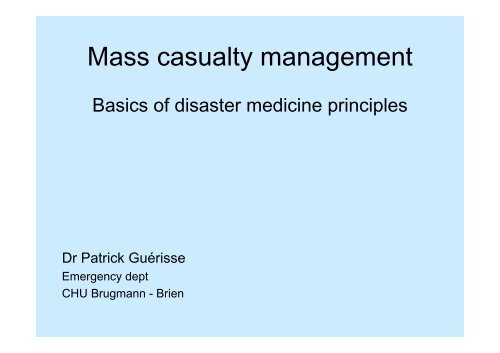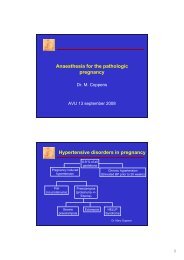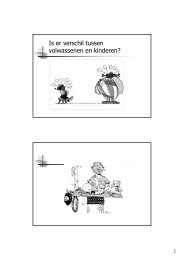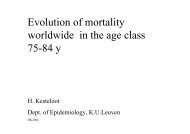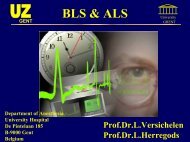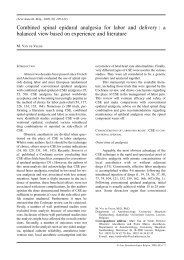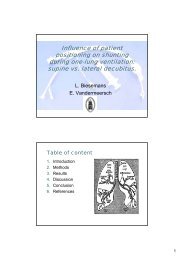Mass casualty management
Mass casualty management
Mass casualty management
You also want an ePaper? Increase the reach of your titles
YUMPU automatically turns print PDFs into web optimized ePapers that Google loves.
<strong>Mass</strong> <strong>casualty</strong> <strong>management</strong><br />
Basics of disaster medicine principles<br />
Dr Patrick Guérisse<br />
Emergency dept<br />
CHU Brugmann - Brien
Why disaster medicine ?<br />
Disaster, did you say ?<br />
• « Titanic turn of mind » :<br />
- sinking is unbelievable<br />
- consequently, preparation is useless<br />
•« Zero risk » does not exist :<br />
– Technological accidents :<br />
Seveso (1976), Bhopal (1984), Chernobyl (1986)<br />
– Human accidents :<br />
Football, music festivals, mass gatherings, riots,<br />
terrorism, etc<br />
• Preparedness :<br />
– about <strong>management</strong> much more than medical aspects<br />
– university curriculum open to non medical agencies<br />
– common language
What is a disaster ?<br />
versus a mass emergency or a mass <strong>casualty</strong><br />
• Sudden discrepancy between<br />
- acute needs and<br />
- locally available resources<br />
• Failure for a community to cope with the<br />
consequences of a damage<br />
• Inability of a community to meet the<br />
demand for health care<br />
! Time sensitive definitions<br />
« Disaster » : to be preferred when there is a major disruption<br />
of the social and medical infrastructure
Specificities of a mass emergency<br />
Different from day-to-day practice<br />
Difference of kind and not only of size<br />
Routine emergency<br />
• Well-understood event<br />
• Limited scale<br />
• Easily manageable<br />
• Quickly under control<br />
• Rescuers familiar with<br />
each other<br />
• Well-accepted authority<br />
• Clear-cut roles and<br />
responsibilities<br />
<strong>Mass</strong> emergency<br />
• Enormous problems<br />
• Breakdown of normal<br />
arrangements<br />
• Multiple procedures<br />
• Large number of rescuers<br />
• Unfamiliarity of the agencies<br />
with each other<br />
• Inadequate initiatives<br />
• Conflicting roles and<br />
responsibilities
Preparedness : disaster plan<br />
• Specific plan = organizational framework<br />
• Hazards identification<br />
• Functional job descriptions & responsibilities<br />
• Incident command system<br />
• Tasks and means of action for each agency<br />
• Inter-agency communication protocols<br />
European Community Seveso directive (1982)
The case of Belgium<br />
• Threshold for activation of the disaster plan<br />
– 5 seriously injured<br />
– 10 or more injured of unknown severity<br />
– possibility or necessity of people evacuation<br />
• Automatic response of the rescue-centre ‘100’<br />
– 5 ambulances<br />
– 3 medical teams (SMUR = MUG)<br />
– warning of<br />
• Director of medical rescue on duty (=medical incident officer)<br />
• Red-cross<br />
• Provincial Medical Inspector
On-site immediate organization<br />
1. Giving alarm first<br />
– Accident of unusual size or appearance<br />
– Brief description of the overall conditions<br />
– Asking for activation of the emergency plan<br />
2. Assessment of the number of victims<br />
3. Gathering the victims<br />
4. Establishing a <strong>casualty</strong>-collection point<br />
(PMA – VMP)
Casualty-collection area<br />
( P.M.A. – V.M.P. )<br />
• Mandatory channel for ALL the victims<br />
• Identification<br />
• Triage<br />
• Minimal medical care<br />
• Allocation to appropriate hospital<br />
• Conditions of transport<br />
• Listing
Medical <strong>management</strong><br />
Should victims be brought to hospitals ?<br />
or<br />
should hospitals be brought to the victims ?<br />
• Depending from the day-to-day routine emergency<br />
organization<br />
• Evidence of research indicates that the better way<br />
is to send mobile medical teams to the scene<br />
• Comparison of London and Madrid terrorist<br />
bombings
Why TRIAGE ?<br />
• Conventional standards of medical care cannot<br />
be delivered to all casualties.<br />
As a consequence, medical resources and<br />
personnel must be allotted to provide<br />
the greatest good for the greatest number<br />
( concept of minimal acceptable care )<br />
• The goal is to identify the small number who will<br />
benefit from early scene <strong>management</strong><br />
Consequently, before giving any care,<br />
the first action must be a rapid examination of<br />
ALL the victims one by one,<br />
to identify the most severely injured.
TRIAGE<br />
• Technique for assigning priorities for<br />
treatment of the injured when the resources<br />
are limited (Surgeon general D. Larrey, 1766-1842)<br />
• START system : for first responders<br />
– Binary sort : severely injured and the others<br />
• Mettag tags : for medical teams<br />
– Categorization into groups,<br />
according with the emergency to treat,<br />
i.e. to evacuate to the appropriate facility
Language-free<br />
Serial number<br />
Detachable corners<br />
Name, address<br />
Body diagram<br />
Predominant injury<br />
Vital signs chart<br />
Detachable<br />
priority tabs
Care on the scene<br />
Medical care is limited to lifesaving actions :<br />
B leeding control and<br />
A irway control<br />
S hock prevention<br />
I mmobilization<br />
C lassification
Hospital disaster plans<br />
• Overcrowding of the nearest facility<br />
by spontaneous uncontrolled flights<br />
• Hospital admission capacity :<br />
- different from the number of beds that<br />
can be made available<br />
- the actual bottleneck is the ER and its<br />
capacity to recruit medical teams<br />
• Efficient use of resources :<br />
– appropriate distribution of the casualties from the scene<br />
– only skilled personnel in the ER
The essential of Disaster Medicine,<br />
in a few words …<br />
• Preparedness<br />
• Quickly recognition and warning<br />
• Triage on site<br />
• Minimal medical care = lifesaving actions<br />
• Regulation :<br />
controlled distribution of the injured to<br />
the adequate hospital


